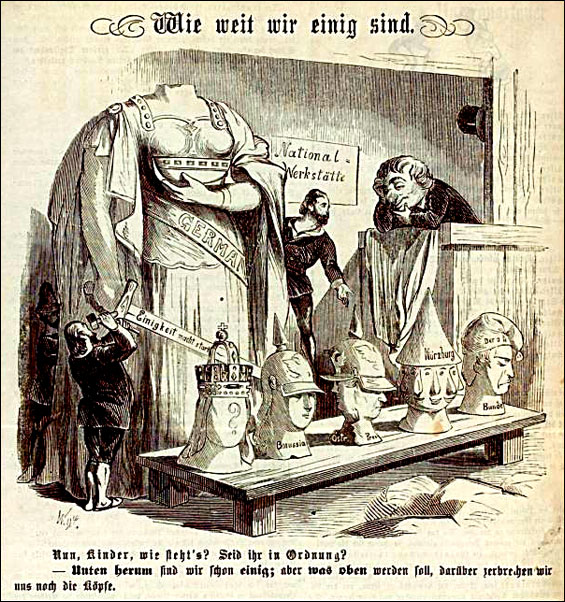













INTRODUCTION | DOCUMENTS | IMAGES | MAPS | EDITOR
|
Political cartoons brought graphic art together with social and political commentary, invariably seeking to amuse readers and sell copies of the journal in which they appeared. Kladderadatsch, founded in Berlin in the revolutionary days of 1848, was one the most influential satirical journals of the era. This cartoon and the two that follow show how image and text were combined to create memorable effects for the target audience. At the beginning of the decade, the question of whether a “large” or “small” Germany [Großdeutschland or Kleindeutschland] would emerge from the struggle between Prussia, Austria, and the smaller federal states was joined by another question: what sort of political and constitutional structure would the new state have? The issue of federal reform thus offered many possibilities – and little agreement – as to which state, or group of states, would take the lead in proposing and rallying consensus for a particular solution to the German question. In this cartoon, the impish figure known as Kladderadatsch (top right) visits the “National Workshop” ["National-Werkstätte"], where German nationalists are busily sculpting the statue Germania. The legs, arms, and torso are complete, and the figure already grasps a sword labeled “In Unity is Strength” [“Einigkeit macht stark”]. But the head (of state) has yet to be chosen among various options. The first option (from left to right) is a head whose only distinct feature is a question mark where its face should be. The next head wears a spiked helmet and is labeled “Borussia,” meaning Prussia. The third, a Janus face, seems to offer the possibility of a continued Austro-Prussian dualism. The fourth, labeled “Würzburg,” refers to a 1859 plan devised in that city by Saxony, Bavaria, Württemberg, and various minor states to prevent both Austria and Prussia from monopolizing power by creating a “Third Germany.” But a clown’s hat and other indicators suggest that this option has already been recognized as without merit. The last head wears an old-fashioned nightcap, suggesting that “the old Confederation” ["der alte Bund"] was not likely to fire the imagination of German patriots in the new decade. Kladderadatsch inquires, “Well, friends, how are things? Have you sorted it out?” The reply comes: “We’re agreed on the bottom part; but we are breaking our heads trying to figure out what should come on top.” Source: “Wie weit wir einig sind,” by Wilhelm Scholz, Kladderadatsch, vol. 14, no. 47 (October 13, 1861), p. 188.
Source: Universitätsbibliothek Heidelberg, Kladderadatsch (1848-1944) - digital. Vol. 14, No. 47, October 1861. |
 print version
print version return to image list
return to image list previous image
previous image
